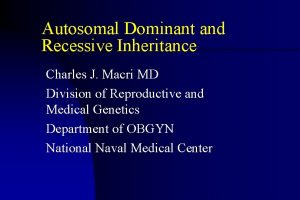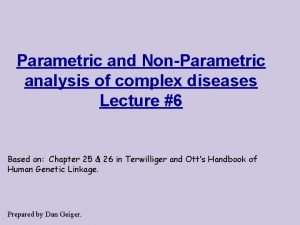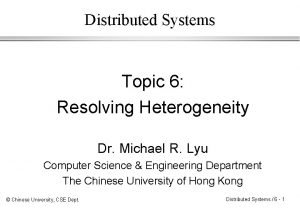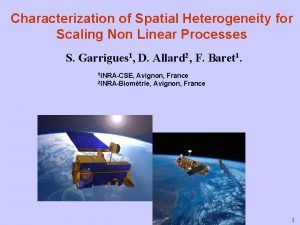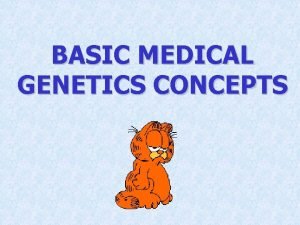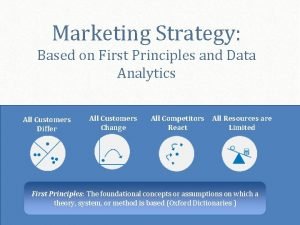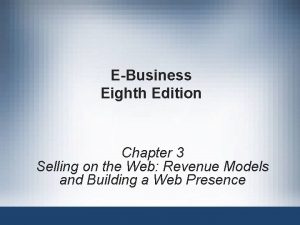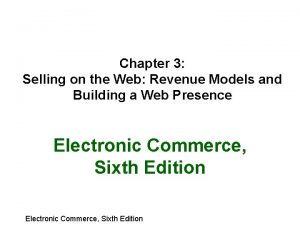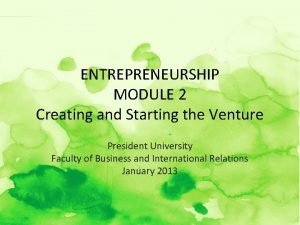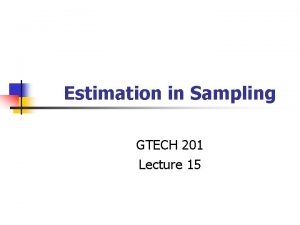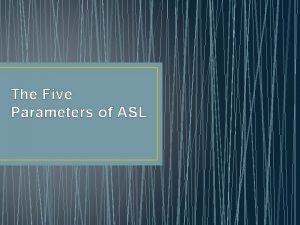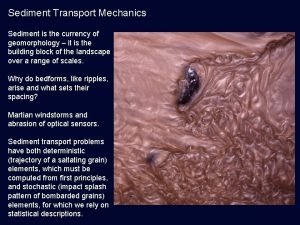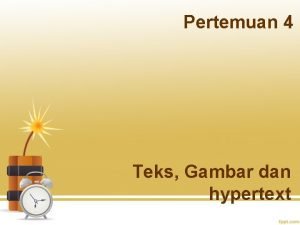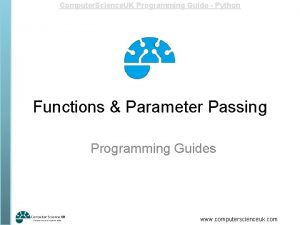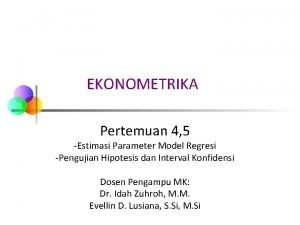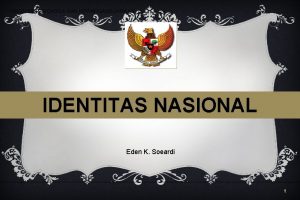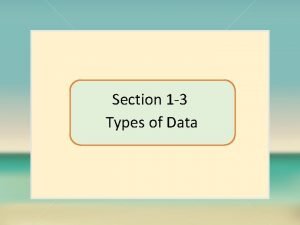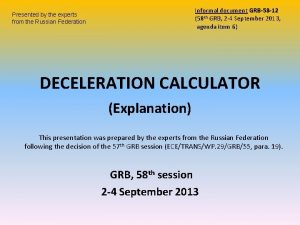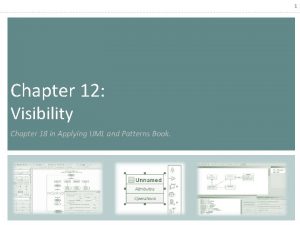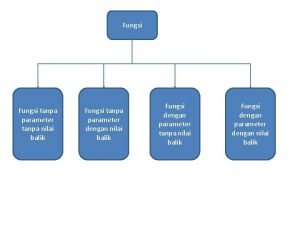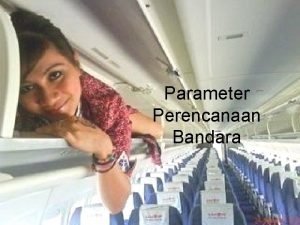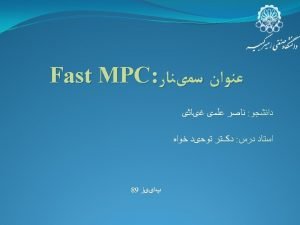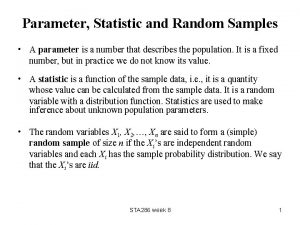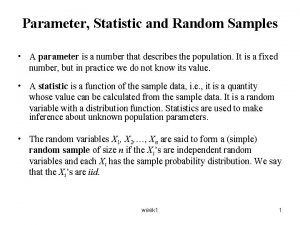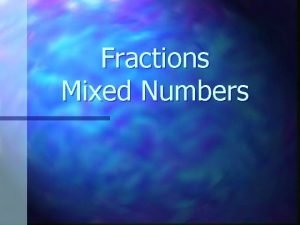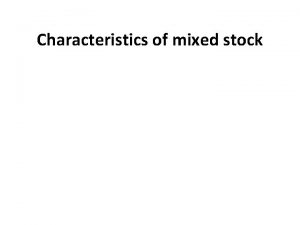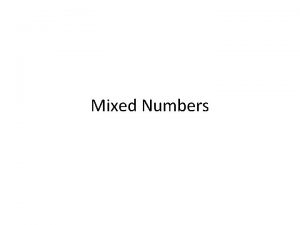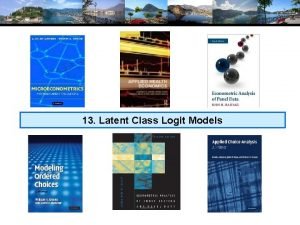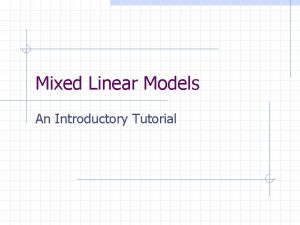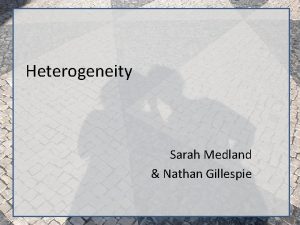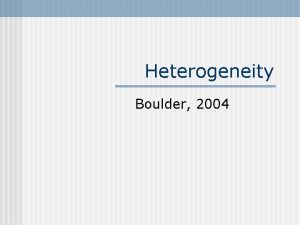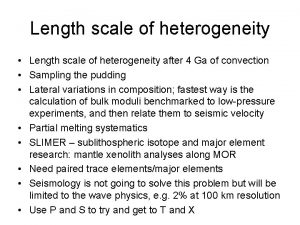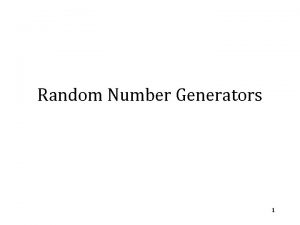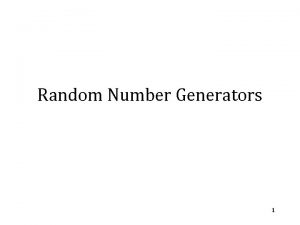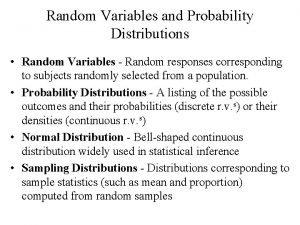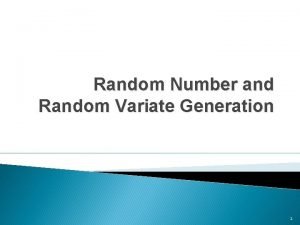9 Heterogeneity Mixed Models RANDOM PARAMETER MODELS A














![Simulating Conditional Means for Individual Parameters Posterior estimates of E[parameters(i) | Data(i)] Simulating Conditional Means for Individual Parameters Posterior estimates of E[parameters(i) | Data(i)]](https://slidetodoc.com/presentation_image_h/ba64cecdffcecdfd0c4dc3ab1bb262f4/image-15.jpg)














- Slides: 29

9. Heterogeneity: Mixed Models

RANDOM PARAMETER MODELS

A Recast Random Effects Model

A Computable Log Likelihood

Simulation

Random Effects Model: Simulation -----------------------------------Random Coefficients Probit Model Dependent variable DOCTOR (Quadrature Based) Log likelihood function -16296. 68110 (-16290. 72192) Restricted log likelihood -17701. 08500 Chi squared [ 1 d. f. ] 2808. 80780 Simulation based on 50 Halton draws ----+------------------------Variable| Coefficient Standard Error b/St. Er. P[|Z|>z] ----+------------------------|Nonrandom parameters AGE|. 02226***. 00081 27. 365. 0000 (. 02232) EDUC| -. 03285***. 00391 -8. 407. 0000 (-. 03307) HHNINC|. 00673. 05105. 132. 8952 (. 00660) |Means for random parameters Constant| -. 11873**. 05950 -1. 995. 0460 (-. 11819) |Scale parameters for dists. of random parameters Constant|. 90453***. 01128 80. 180. 0000 ----+------------------------------- Implied from these estimates is. 904542/(1+. 904532) =. 449998.

Recast the Entire Parameter Vector



S M

MSS M

Modeling Parameter Heterogeneity

A Hierarchical Probit Model Uit = 1 i + 2 i. Ageit + 3 i. Educit + 4 i. Incomeit + it. 1 i= 1+ 11 Femalei + 12 Marriedi + u 1 i 2 i= 2+ 21 Femalei + 22 Marriedi + u 2 i 3 i= 3+ 31 Femalei + 32 Marriedi + u 3 i 4 i= 4+ 41 Femalei + 42 Marriedi + u 4 i Yit = 1[Uit > 0] All random variables normally distributed.

![Simulating Conditional Means for Individual Parameters Posterior estimates of Eparametersi Datai Simulating Conditional Means for Individual Parameters Posterior estimates of E[parameters(i) | Data(i)]](https://slidetodoc.com/presentation_image_h/ba64cecdffcecdfd0c4dc3ab1bb262f4/image-15.jpg)
Simulating Conditional Means for Individual Parameters Posterior estimates of E[parameters(i) | Data(i)]

Probit



“Individual Coefficients”

Mixed Model Estimation Programs differ on the models fitted, the algorithms, the paradigm, and the extensions provided to the simplest RPM, i = +wi. • • Win. BUGS: • MCMC • User specifies the model – constructs the Gibbs Sampler/Metropolis Hastings MLWin: • Linear and some nonlinear – logit, Poisson, etc. • Uses MCMC for MLE (noninformative priors) SAS: Proc Mixed. • Classical • Uses primarily a kind of GLS/GMM (method of moments algorithm for loglinear models) Stata: Classical • Several loglinear models – GLAMM. Mixing done by quadrature. • Maximum simulated likelihood for multinomial choice (Arne Hole, user provided) LIMDEP/NLOGIT • Classical • Mixing done by Monte Carlo integration – maximum simulated likelihood • Numerous linear, nonlinear, loglinear models Ken Train’s Gauss Code • Monte Carlo integration • Mixed Logit (mixed multinomial logit) model only (but free!) Biogeme • Multinomial choice models • Many experimental models (developer’s hobby)

Appendix: Maximum Simulated Likelihood

Monte Carlo Integration

Monte Carlo Integration

Example: Monte Carlo Integral

Simulated Log Likelihood for a Mixed Probit Model

Generating a Random Draw

Drawing Uniform Random Numbers

Quasi-Monte Carlo Integration Based on Halton Sequences For example, using base p=5, the integer r=37 has b 0 = 2, b 1 = 2, and b 2 = 1; (37=1 x 52 + 2 x 51 + 2 x 50). Then H(37|5) = 2 5 -1 + 2 5 -2 + 1 5 -3 = 0. 448.

Halton Sequences vs. Random Draws Requires far fewer draws – for one dimension, about 1/10. Accelerates estimation by a factor of 5 to 10.
 Allelic heterogeneity
Allelic heterogeneity Heterogeneity marketing
Heterogeneity marketing Allelic heterogeneity
Allelic heterogeneity Out-group homogeneity bias
Out-group homogeneity bias Heterogeneity distributed systems
Heterogeneity distributed systems Savana
Savana Allelic heterogeneity
Allelic heterogeneity All customers differ
All customers differ Random assignment vs random sampling
Random assignment vs random sampling Random assignment vs random selection
Random assignment vs random selection Advertising subscription mixed revenue models
Advertising subscription mixed revenue models Advertising-subscription mixed revenue model
Advertising-subscription mixed revenue model Advertising subscription mixed revenue models
Advertising subscription mixed revenue models Semi-modals
Semi-modals Parameter analysis in entrepreneurship
Parameter analysis in entrepreneurship Population parameter symbol
Population parameter symbol 5 parameters of asl examples
5 parameters of asl examples Toomre q parameter
Toomre q parameter Shields parameter
Shields parameter Format gambar digital memiliki parameter
Format gambar digital memiliki parameter Parameter computer science
Parameter computer science Nvna parameter measurement
Nvna parameter measurement Musikalische parameter
Musikalische parameter Parameter populasi adalah
Parameter populasi adalah Ekonometrika
Ekonometrika Unsur unsur pembentuk identitas nasional
Unsur unsur pembentuk identitas nasional Statistic vs parameter example
Statistic vs parameter example Keldysh parameter calculator
Keldysh parameter calculator Parameter visibility from a to b exists when
Parameter visibility from a to b exists when Fungsi tanpa nilai balik
Fungsi tanpa nilai balik
